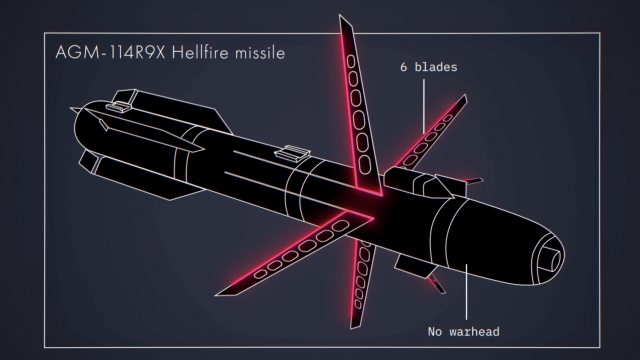The U.S. targeting of two pro-Iranian paramilitary leaders in Baghdad Wednesday is a significant escalation in the American response to the death of three U.S. soldiers in Jordan in January.
Notably, the missile used in the attack may have been a rarely used and secretive variant that utilizes blades instead of explosives to kill its target.
Sometimes called the "Flying Ginsu," the missile's full name is the AGM-114R9X Hellfire, or just the R9X. It's a version of the U.S.'s widely-used Hellfire missile that uses six blades instead of explosives to minimize collateral damage.
Images shared on social media showing the munition remnants appear to match up with what we've seen in past strikes in which the weapon was used: a circular section with protruding metal struts that would be the missile's blades. Previous strikes in Syria bore the same hallmarks.
Video from social media shows the targeted vehicle engulfed in flames — which typically isn't a sign of the R9X being used, as it doesn't have explosives in it.
But video showing the car after the fire was put out shows it with a caved-in top, not unlike what we've seen with past R9X strikes on vehicles.
The R9X doesn't get used often — we've mostly seen evidence of its use in Syria as early as 2017.
Notably, it's thought to have been used in the killing of al-Qaida's top leader in Afghanistan in 2022.
The Pentagon confirmed the strike in Baghdad not long after the images and video started coming out on social media.
SEE MORE: US says retaliatory strike in Baghdad killed Iranian-backed officer
This would be the first time we've seen U.S. Central Command publicize an attack using the R9X, though they didn't mention what munition was used.
Still, it may be a sign that the secretive layers of the R9X are being pulled away as it becomes another tool for the U.S. to use in strikes in which minimizing civilian casualties is a top priority.
Despite its gruesome methods — utilizing blades isn't exactly a clean kill — the R9X does cut down on collateral damage due to its non-explosive nature.
Still, some human rights experts question whether such strikes are legal.
Letta Tayler, an associate director in the Crisis and Conflict Division at Human Rights Watch said "The R9X is only going to be as good as the intelligence used to guide it. So even if the US determines it wants to kill a particular person, that doesn't mean that it can legally do so under international law. You can't just go out and kill somebody because you think they might be a security threat."
The head of Iraq's military released a statement condemning the strike in Baghdad, calling it an assassination and saying it violated Iraqi sovereignty.
SEE MORE: Tracking The 'Sword Bombs' Of America's Drone War
Trending stories at Scrippsnews.com



